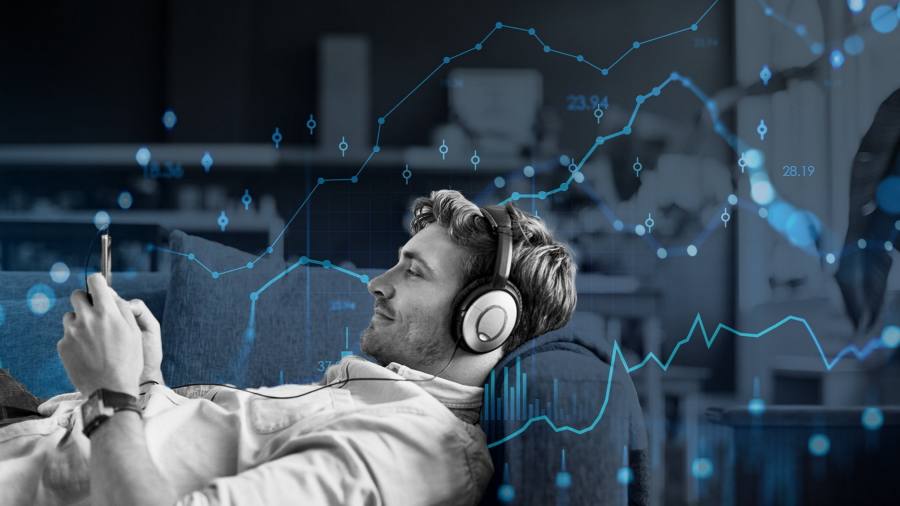Receive free Artificial intelligence updates
We’ll send you a myFT Daily Digest email rounding up the latest Artificial intelligence news every morning.
Mathematical relationships underpin the arrangement of notes in a composition — and that makes music particularly open to AI-powered tools, which can be taught to recognise and create melodies and rhythms. Such tools are spreading at a rapid rate across all levels of the music industry, from streaming platforms and record labels to musicians and producers. Their adoption is provoking anxiety about mechanisation, but also enthusiasm for their transformative potential.
Applications of AI in music
STREAMING RECOMMENDATIONS
Streaming services such as Spotify use AI to map their users’ listening habits. By breaking down a person’s tastes according to the tempo or mood of their favourite music, deep-learning algorithms are able to build personalised recommendations for other songs. General listening trends are also analysed to customise playlists for users. Social media and internet sites are scoured for keywords about songs in order to build up profiles about how people are listening to them. For example, a song can be assigned a sadness rating, which can then be used to match it to a person who likes sad songs.
Sceptics complain that these algorithmically driven recommendations turn listeners into automatons. But their function is to open up huge song libraries such as Spotify’s catalogue of over 70mn tracks, which would otherwise be unnavigable for subscribers. Machine-learning algorithms are also used to enhance streaming quality by monitoring a user’s internet connection and tailoring the audio bitrate accordingly.
SONG-WRITING
Boomy is an AI music generator that claims to have created more than 16mn original songs since its launch in 2019. In May, Spotify reportedly purged thousands of these tracks from its catalogue following accusations that bots were being used to artificially inflate the streaming numbers for — and revenues made by — these songs.
Like rival applications, Boomy makes music based on simple prompts from users. These commands are becoming more straightforward as the technology advances. In May, Google released MusicLM, an app that creates music from written commands such as “calming violin melody” or “distorted guitar riff”.
Vocal cloning is another area where AI is making waves. Computers are trained on recordings of people’s voices so as to create a copy that can be made to utter whatever its user chooses. Often, this will be a whimsical juxtaposition in which an AI-generated Frank Sinatra might sing Britney Spears’ “Toxic”. But others are deepfake acts of impersonation such as “Heart on My Sleeve” — a duet with the cloned voices of Drake and The Weeknd that went viral earlier this year. It was removed from streaming platforms after the artists’ record label Universal Music Group complained.
Musicians have split opinions. “This song sucks,” was Nick Cave’s pithy response to lyrics generated by AI chatbot ChatGPT in his style. According to Sting: “The building blocks of music belong to us, to human beings.” But Grimes has made cloned copies of her voice available for licensed use, while David Guetta was taken aback by the keen audience response when he dropped a fake Eminem vocal into a DJ set earlier this year.
MUSIC PRODUCTION
“The largest implication for AI and music is that creation is going to get easier,” says Jessica Powell, chief executive of San Francisco-based start-up Audioshake. It uses a form of AI technology called audio source separation to identify the components of a piece of music and strip them apart into so-called stems.
Audioshake can be used to remix songs or turn them into instrumentals for music libraries that license music for use in television, films, commercials and video games. It enables a songwriter to experiment with different ideas, such as whether a female or male vocalist might work best in a piece of music. Among its clients is an Augmented Reality app called Minibeats that allows people to create sounds through facial expressions and physical movements.
“The aim is to make audio more editable, accessible, interactive and immersive,” she says. Such developments are the latest stage in a process that began with the rise of multitrack recording in the 1950s when songs began to be assembled from separately recorded parts. That was the era of stereo sound. Today’s equivalent is spatial audio, as promoted by Apple Music, which creates the illusion of experiencing music from all directions.
RECORD LABELS
The traditional music industry is wary of AI. Universal, the world’s biggest label, has argued for copyright to be applied to the data used for machine-learning, such as the vocal stems used to train computers to make voice clones.
Virtual entertainments, such as the digital avatars in ABBA Voyage, have been hits, but attempts to launch virtual stars have been less successful. FN Meka, publicised as the first AI-generated rapper to be signed to a major label, was dropped within days by Capitol Records in 2022 for racial stereotyping.
Powell argues that fears of an AI takeover in music are overblown. Human talent will continue to be central even as the work itself becomes ever more technologically driven. “What is the story behind a song?” she says. “Who is performing it? What is their larger social or cultural context? How are they interacting with their fans? Taylor Swift is far more than a Taylor Swift song.”
Read the full article here



